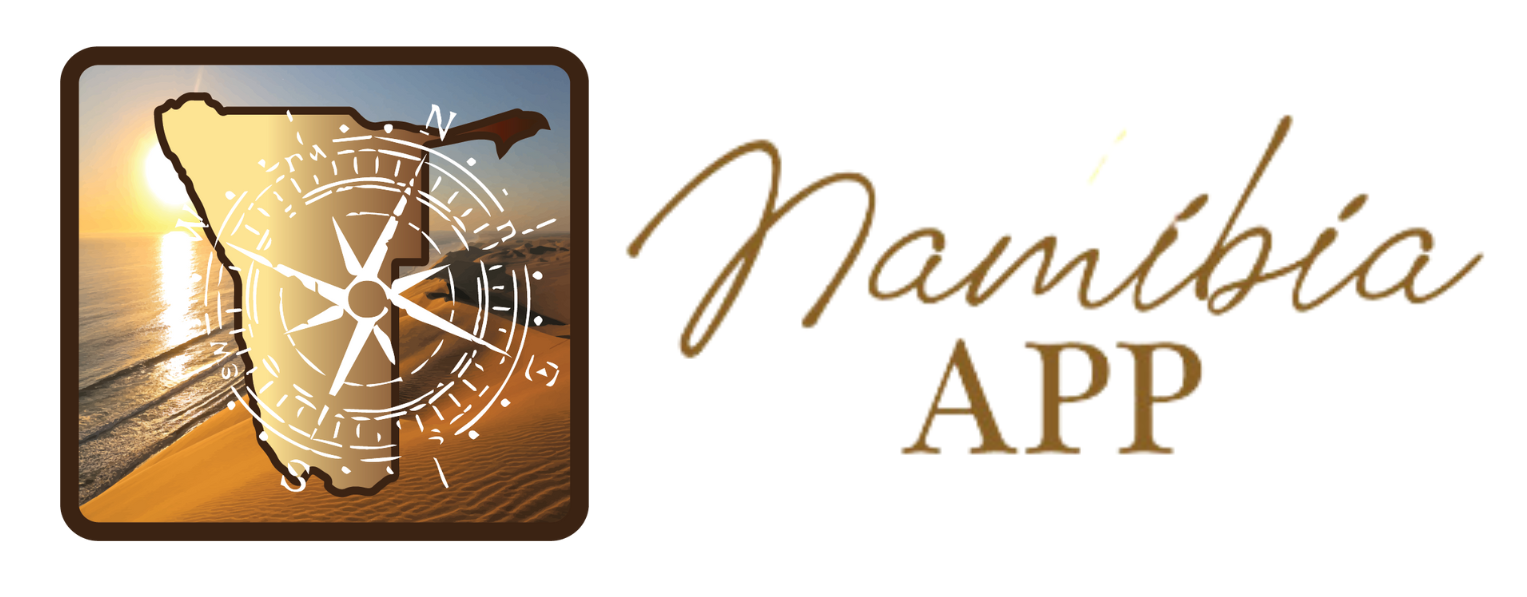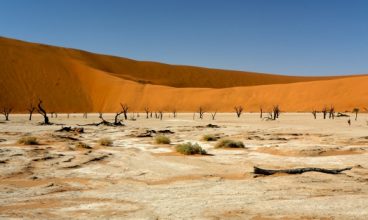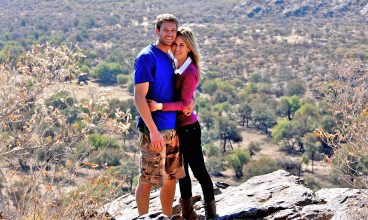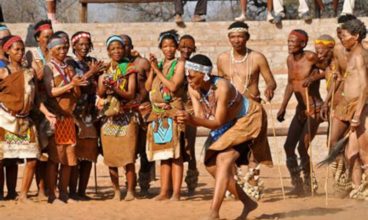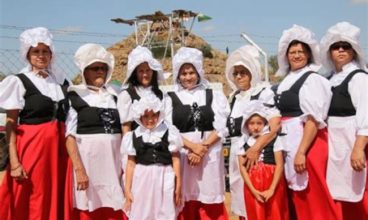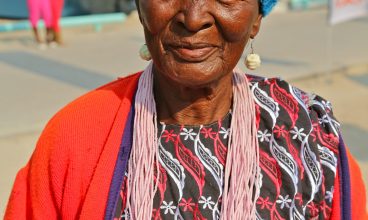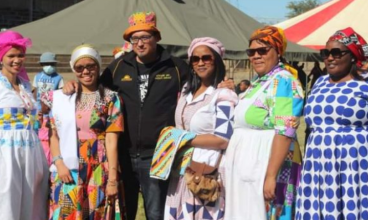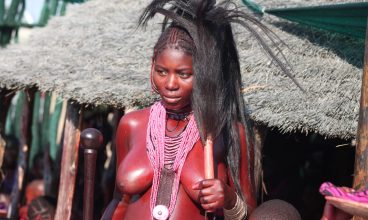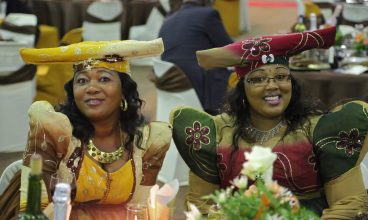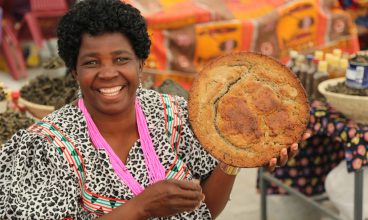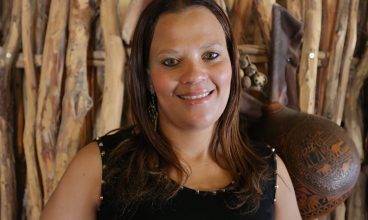Understanding Namibia: A Demographic Overview Discover the Land, People, and Essentials of Namibia’s Diversity General Surface Area: 825,000 km2 Capital: Windhoek Independence: 21 March 1990 Political System: Democracy Leading Party: SWAPO President: Netumbo Nandi-NdaitwahFreedom of Religion: 90% Christian Population Population Amount: 2,9 million people of which 15% (240,000 people) live in the capital of Windhoek. Population Density: 3,5 people/km2 Languages: English is the official language of Namibia. Afrikaans and German are also widely spoken. In total, 16 languages and dialects are spoken by 13 ethnic cultures. Climate Namibia is one of the driest countries south of the Sahara. 70% of the country’s rainfall occurs between December and March. Summer temperatures reach above 35°C in the summer months (October – April). During winter (May – September) days are warm but nights are very cold, often below 0°C. The country is wedged between the Namib Desert in the West and the Kalahari Desert in the East. Money Currency: The Namibian Dollar (N$) is fixed to the value of the South African Rand (ZAR/R) which can also be used as legal tender. All major credit cards are accepted. Banking Hours: Monday – Friday: 09:00 – 15:30 Saturdays: 08:30 – 11:00 VAT Refunds: for purchases exceeding N$ 250, foreign tourists can obtain a VAT refund (15%) at their port of exit, provided that all cash slips have been kept. Tourism Levy: All accommodation establishments are obliged by law to charge a tourism levy of either 1% (all-inclusive rate) or 2% (Bed or B&B rate). Telephone & Communication Namibia has direct dialling facilities to 221 countries. Mobile communication is well supported by various service providers with international roaming agreements in place with over 100 countries. Dailing Codes Calls from outside Namibia Country Code: ++264 plus Area code (without the “0”) plus telephone number (usually 6 digits) Example: ++264 61 123456 Calls from inside Namibia Area Code (eg 061 or 067 or 064 etc) plus telephone number( eg 061 123456) Transport Only about 12% of all roads are tarred; within the country gravel roads are predominant. Harbours: Luderitz and Walvis Bay Main Airports:-Hosea Kutako International Airport (40 km outside Windhoek) -Eros Airport (within Windhoek) – mainly domestic charters. -Ondangwa Airport – mainly domestic charters and regional flights. Otherwise, many airstrips (approx. 45) are available throughout Namibia. Extensive network of regional and international flights to Windhoek; domestic charters to all destinations. Public transport:–Very limited Bus service: Whk – Cape Town – Johannesburg – Vic FalIs – Swakopmund. -Travel by train: operates between Karasburg in the south, Windhoek in the central, Swakopmund in the West, Gobabis in the East and Ondangwa in the North. Flora & Fauna Namibia boasts 120 different species of trees, 200 endemic plant species and more than 100 lichen species. The Welwitschia Mirabilis is Namibia’s living fossil plant. On the Fauna front Namibia offers the big 5: Lion, Leopard, Buffalo, Elephant and Rhino, plus Cheetah and Giraffe and about 20 antelope species and hundreds of mammal and reptile species, not to forget over 670 bird species. Nature reserves cover 15% of the entire surface area. Perennial rivers run only in the south (Orange River) and the north (Kunene, Okavango, Zambezi and the Kwando/Lynianti/ Chobe) whereas ephemeral rivers run only during the rainy season (Le. December to March), amongst those are the Fish River, the Kuiseb, the Ugab and the Swakop Rivers.
Read MoreThe Whites Early pioneers of European descent started settling in southern Namibia in the 1800s. They were mainly Afrikaners infiltrating from South Africa, and German and British missionaries.The major contribution of the English-speaking community to Namibia is undoubtedly the English language. When Namibia attained independence in 1990, English was selected as the official language, and today it is the main language of instruction in state-run schools throughout the country. After serving with German as one of three ‘official’ languages, Afrikaans was relegated to a secondary position. Prior to independence, however, it was the main language of instruction in state-run schools, and was the lingua franca spoken by approximately 90 per cent of all Namibians. Nevertheless, it is still a prominent language, as it is the first language spoken by Namibia’s Afrikaners, Rehoboth Basters and Coloured More or less 100 000 Namibians of European descent currently live in the country, most of them in the urban, central and southern areas. They are mainly involved in farming, commerce, manufacturing and professional services. About two-thirds of them speak Afrikaans, one quarter German and the rest, according to the latest population census not more than 8 000, primarily English. The latter don’t all have English ancestry, many being descended from Italians, French and Portuguese people who settled in the country and adopted English as their home language. The first British presence was established in Namibia in 1807, when the London Missionary Society, which had based itself along the Orange River in 1802, became active north of the river at Warmbad and Blydeverdacht. They and the Wesleyan Methodist Missionary Society transferred their rights to the Rhenish Missionary Society in the mid-1800s. Historically Afrikaner was the name applied to the descendants of Dutch and French-Huguenot settlers who emigrated to South Africa at the end of the seventeenth century, entering the country by sea and landing at the Cape of Good Hope. The Afrikaans language as it is spoken today evolved from the Dutch dialect spoken by these settlers. According to some sources many Whites in the Cape regarded themselves as being rooted in Africa, and this concept found expression in the term ‘Afrikaner’. Namibia’s Afrikaners infiltrated gradually from South Africa during the 1800s. An interesting group was the so-called Dorsland Trekkers, one of several ‘treks’ of Afrikaners who moved northwards from the Great Marico in South Africa’s northern Transvaal over the Limpopo in search of new land. In the second half of the nineteenth century, after endless wanderings, some of them settled in Angola, where they lived for about 50 years, before moving to Namibia in the 1920s.
Read MoreThe Tswana The Tswana migrated from East Africa into central Southern Africa in the 14th century. They are closely related to the Sotho of Lesotho and South Africa and the two groups are bonded in language and customs. They claim a common ancestor, Mogale, and share an agrarian culture, social structures, political organisation, religious and magical beliefs and also a family life. All the Sotho and Tswana languages are inherently intelligible, but for political and historical reasons, they have generally been considered three Traditional Tswana society included men, women, children and ‘badimo’ (ancestors – living dead – who have metaphysical powers). A Tswana doesn’t think in terms of individual rights but of responsibilities to his family and tribe. The father is to be obeyed and respected by his wife and children at all times. The Sotho-Tswana are organised by lineages, which developed as the tribe grew. The lineages are organised in sub-units and communities. Every level exhibits the same social organisation, such as the Kgotla, the traditional court, with various officials assigned different duties in the social structure at each level. In traditional Tswana religion (tribal animism) Modimo is the great God, or The Great Spirit. The Tswana are the smallest cultural group in Namibia and are quite distinct from the Tswana of Botswana. Their ascendants embarked on a thirstland trek through Botswana to settle in Namibia at the end of the nineteenth century, considerable numbers succumbing along the way. Namibia’s Tswana are divided into three groups. The largest is the Tlharo, who originally came from Kuruman in the northern Cape. The second-largest group is the Tlhaping, ‘tlhapi’ meaning ‘fish’ in Tswana. The third and smallest group, the Bangologa, have mixed with the Kalahari Bushmen to some extent and are lighter in colour. Today they live in a triangle, with a line between Epukiro and Aminuis in the east as its base, and extending to Walvis Bay, its vertex, in the west. Most of them, however, live in the east of the country where they are involved in farming, many having bought farms north and south of the town.
Read MoreThe Rehoboth Basters The Rehoboth Basters regard themselves as a distinct community under their unique history and the fact that they have been living in their territory for over a century. Their origin dates back to 1652 when the first Dutch colonists under Jan van Riebeeck landed at the Cape of Good Hope. European settlers came into contact with the local Khoesan peoples and the children born from this association were called ‘bastards’ or ‘coloureds’, giving rise to two distinctly separate groups of people, descendants of whom later moved to Namibia. In the mid-1800s, some ninety Baster families moved northwards from the Cape, first residing at Warmbad, then migrating northwards to Berseba and in 1870 finally settling at the hot-water springs called Rehoboth. This area had formerly been occupied by a Nama tribe, the Swartboois, who had moved to Bokberg or Erongo over Otjimbingwe and Salem, and eventually to Fransfontein. In due course, the Rehoboth Gebiet became the fatherland of the Basters, recognised as such by the South African Government as early as 1915. The Rehoboth Baster community of today consists of approximately 72,000 people. Their first language is Afrikaans, and their way of life resonates with their Afrikaner forebears. In Baster society, the family is the most important socioeconomic unit, functioning independently within the community. At their request, they are registered as Rehoboth Basters, as they regard themselves as a separate community from the Coloureds. While the word ‘Baster’ traditionally denoted ‘of mixed blood’ in a derogatory way, the group calls themselves Rehoboth Basters with pride. Their surnames reflect that they are of mixed descent, as evidenced in well-known Baster family names such as the Afrikaans Cloete, Beukes, Diergaardt, Mouton, Maasdorp, Louw, Coetzee and Van Wyk; the English and Scottish Wentworth, McNab and Dunn; the German Bayer, Rittmann and Husselmann; the Nama Witbooi; the Damara Garises and Gowaseb and even the Italian Bertolini. Traditionally stock and crop farmers, today’s Rehoboth Basters are involved in many other economic sectors, especially the building trade. A large number commute to Windhoek on a weekly or daily basis. Christianity has greatly influenced Baster communities and lifestyles, playing an important role in their lives to this day. There are no less than 40 churches in the small town of Rehoboth, mostly Lutheran and Roman Catholic, with many splinter groups, several of which are amalgamations of traditional tribal beliefs with Christianity. An annual festival that serves to strengthen the national identity of the Rehoboth Basters is the two-day commemoration of their confrontation with the German colonial troops at the place called Sam Khubis on 8–9 May 1915. A group of Basters had resisted joining the Germans against the South African forces, especially when they realised that the South Africans were likely to gain the upper hand. Fearing for the safety of their families, they left Rehoboth with their wives and children and took refuge among the koppies at Sam Khubis. Here, they were ambushed by the German forces and suffered many casualties. Upon hearing that large contingents of South African troops were advancing from the south, the Germans unexpectedly withdrew, and the Basters gained the impression they had retreated. The Basters have commemorated these two days every year ever since. In 2000 a monument was built at the site to honour their kinsmen who had lost their lives at Sam Khubis.
Read MoreThe Owambo The roaming nature and flexibility of the Owambo, coupled with the cycle of the seasonal efundja, very much define their character as a people. In about 1550 the tribes referred to collectively as the Owambo moved down from the Great Lakes in East Africa to settle between the Kunene and Okavango rivers in central-northern Namibia. The Owambo consist of eight tribes, the largest being the Kwanyama. The other tribes are the Ndonga, Kwambi, Mbalantu, Kwaluudhi, Ngandyela and the smaller Nkolonkadhi and Unda. Following Namibia’s independence in 1990, what was traditionally known as Ovamboland or Owambo was divided into four regions: Omusati, Oshana, Ohangwena and Oshikoto. While these four regions are still where the majority of Owambo people live, large numbers have migrated southwards and settled throughout the length and breadth of the country, forming the major part of the workforce in the mining and fishing industries. During the rainy season life on the vast plains of Owambo depends on the efundja, the floods that feed the flat, shallow depressions called oshanas. Here a mixed economy of agriculture and farming with livestock is practised. Major crops in the agronomy sector are mahangu (pearl millet), maize, groundnuts and sorghum, while livestock consists mainly of cattle, goats and chickens, supplemented by fishing in the oshanas. Groups of women are involved in home industries such as basketry, dressmaking, pottery and woodcarving. While Owambo women traditionally cultivated the land and raised the children, they are nowadays increasingly entering the labour market as civil servants, nurses, teachers and shop assistants. An intriguing side to these versatile people is their natural bent for trading, borne out locally in the over 10,000 stalls, cuca shops (where liquor is served and sold) and shopping complexes in the region. One of Namibia’s most successful businessmen is multi-millionaire Frans Indongo, who built Frans Indongo Gardens in Windhoek. More than any other of Namibia’s population groups, the Owambo have consistently played an active role in politics. The South West Africa People’s Organisation, Swapo, has been the ruling party since independence. It started as a non-violent pressure group, the Owambo People’s Organisation, led by Adimba Herman Toivo ya Toivo and Samuel Shafiishuna Nujoma, the man destined to become the first president of an independent Namibia. He was succeeded by fellow countryman and former Cabinet Minister, Hifikepunye Pohamba. The current President of Namibia is Dr. Hage Geingob.
Read MoreThe Nama The Nama people, who call themselves the Red Nation, /Awakhoen, are the only true descendants of the Khoekhoe in Namibia. They originally lived in the northern part of the Cape Province, where they adopted the use of horses from the European settlers, living as nomads defending their territories against invaders seeking pasture. In the nineteenth century, they were already living south and north of the Orange River when Jager and Jonker (father of Jan Jonker) crossed it with the Afrikaner tribe The Afrikaners and four other Nama tribes represented the so-called Oorlam group. Pushed continuously northwards by a rapidly advancing white farming community and led by the famous Jan Jonker Afrikaner, the Nama settled in the southern and central areas of the country. Today the differentiation between Nama and the Oorlam is merely of historical significance. When Herero migrating from the north intruded into Nama pasturelands, a fierce and prolonged battle developed between these two groups. The conflict was brought to an end by German colonial forces in the late 1800s, and home areas including Berseba, Gibeon (Krantzplatz), Bondels, Sesfontein, Soromas and Warmbad were offered to the Namas. Today the concept of communal land ownership still prevails among the Nama tribes, with the exception of the =|Aonin or Topnaars of the Kuiseb environs, whose !nara fields are the property of individual lineages. Traditionally, as pastoral nomads, they had little need for permanent structures, their beehive-shaped rush-mat huts providing such shelter as they required. There are several similarities between the Nama and the San (Bushmen). The Nama are generally short in stature and comparatively light in colour, with certain characteristic features, such as the small, slender hands and feet of the women. They also share linguistic roots with the San, speaking with the distinctive click sounds. The Nama have a substantial oral tradition. Numerous proverbs, riddles, tales and poems have been handed down from generation to generation, the poems ranging from love songs and praise of heroic figures, to songs of the animals and plants in the environment. They also have a natural talent for music and dance. An example of a traditional dance is the well-known Nama stap. Traditionally the Nama people were hunter-gatherers and also pastoral herders breeding cattle, goats and sheep. It was the Nama who introduced fat-tailed sheep to Namibia. Nama women have an inborn talent for creative needlework and embroidery and several co-operative projects have been initiated in the south to promote and market their handiwork. Another craft typical of the Nama people is the kaross or blanket made from skins sewn together, formerly worn by Khoesan and other African people, and nowadays used as a bed or floor covering.
Read MoreThe Himba Due to the extensive interest and wide publicity afforded the Himba, semi-nomadic people who still live and dress according to ancient customs and traditions, they are, next to the Bushmen, arguably the best known of Namibia’s people. With the Tjimba and other Herero people who inhabit Kaokoland, the traditional name of Namibia’s remote north-western Kunene Region, they are informally referred to as the Kaokovelders. The Himba live in scattered settlements throughout the region. Their homes are simple cone-shaped structures made of saplings bound together with palm leaves and plastered with mud and dung. The men build the structures, while the women mix the clay and do the plastering. In the headman’s hut, a fire burns day and night, both to keep away insects and to provide heat and light. Families often have several of these huts in different locations, moving from home to home a few times a year in search of grazing for their cattle and goats. The Himba are tall, slender and statuesque people, renowned for their beauty and photogenic qualities. They are dignified yet friendly people and are willing to have their photographs taken if asked beforehand. The women especially are admired for their unusual sculptural features, enhanced by intricate hairstyles and traditional adornments. They rub their faces and bodies with a mixture of ground red ochre, animal fat and herbs, which protects their skin against the harshness of the desert and keeps insects away. Himba women spend as much as three hours a day to wash and dress. They use a separate mixture of butterfat, herbs and black coals to rub on their hair, and ‘steam’ their clothes over the permanent fire. Himba males wear different hairstyles to the women, such as the single plait, ondato, worn by young boys down the back of the head, the ozondato, two plaits, worn by Himba men when they reach marriageable age and the ombwiya headdress, a scarf made from fabric covering the hair and decorated with an ornamental band, worn by married men. A young girl typically has ozondato (plaits). Once she has undergone the puberty ceremony, she wears the ekori headdress made from tanned goat or sheepskin with three leaf-shaped points that are usually decorated with iron beads. ypical Owambo artefact and immensely popular in modern Namibian hand-crafted jewellery is the ekipa, an ornamental button made from ivory or bone. Ekipas were carved into oval, round, square or rectangular shapes with a raised centre, resembling a tiny beehive. They are usually engraved around the outer edge with a border depicting different geometric patterns. In earlier times ekipas were worn by the women on two leather straps hanging down from the waist at the back, the number of ekipas displayed giving an indication of the wealth and status of the woman’s husband. Himba women make finely woven baskets with elegant sculptural shapes, traditionally used to hold milk and butter. Some have leather handles decorated with iron beads. They also make a variety of jewellery, mostly with leather, iron and ostrich eggshell beads, shells and carved makalani nuts (vegetable ivory). An interesting Himba craft is dolls, made from fabric and rubbed red with the ochre mixture.
Read MoreThe Herero It is believed that in ancient times the Herero lived in a legendary African marshland of water and reeds known as Roruu before undertaking their southern migration down the African continent. While this legendary marshland has never been traced, according to oral tradition they moved southwards from the great lakes of East Africa, crossed into present-day Zambia and southern Angola and arrived at the Kunene River in about 1550. After inhabiting Kaokoland (today’s Kunene Region) for some 200 years, the Herero and the Mbanderu migrated independently of each other in a southerly direction, leaving the Himba and Tjimba tribes behind. This brought them into conflict with the Nama occupying the southern and central regions of the territory. They reached the Swakop River valley towards the middle of the 18th century, and during the 19th century moved eastwards. Eventually, the Herero established themselves in the central region, and the Mbanderu settled east of Windhoek. The Herero–German wars of 1904–1907 resulted in a drastic decimation of the Herero. A very large number were killed or succumbed as they fled, according to some estimates as much as eighty per cent of the population. The survivors were left with no land and cattle, and more or less disintegrated as a group, many fleeing to Botswana (the former Bechuanaland). When South Africa took over the administration of South West Africa in 1915 they began to return and were gradually allocated home areas at Aminuis, Epukiro, Waterberg East, Otjohorongo and Ovitoto. Despite the hardships and suppression of their traditional cultures, they managed to keep their bonds of family life, tribal solidarity and national consciousness alive, as is evidenced by the annual Herero Festival in August on Maharero Day when various units of paramilitary organisations parade before their leaders in full regalia through the streets of Okahandja. The Mbanderu and Zeraua tribes honour their captains in festivals in Gobabis and Omaruru. It was during the nineteenth century, under the influence of the wives of missionaries, that Herero women developed the wide multi-skirted Victorian-style dresses that the more traditional women still wear today. The distinctive headdress made from fabric characterised by two points on either side symbolises cattle horns. Today there are over 130 000 Herero-speaking Namibians in the country, subdivided into the following groups: The Herero with the traditional chiefdoms of Maharero in the Okahandja area, the Zeraua in the Omaruru environs; the Kambazembi of Waterberg; the Ndamuranda; the Mbanderu of eastern Namibia, especially the Gobabis District and the reserves of Epukiro, Otjombinde and Aminuis; the Tjimba Herero of Kaokoland (Kunene) and the Himba of the Kunene Region, which are discussed below as a separate group.
Read MoreThe Damara The origins of the Damara, who belong to one of the oldest cultural groups in Namibia, are somewhat of an enigma. One of several puzzling aspects is that while they differ completely from the Nama in appearance and lifestyle, they speak the Nama language. In former years the Damara had the widest geographic distribution in the country, but they were gradually ousted from their traditional areas by advancing Nama and Herero seeking new pasturelands. Today they are concentrated in the environs of Outjo, Kamanjab, Khorixas and Brandberg region, traditionally called Damaraland, and since independence, delineated as the Erongo Region. According to the 2001 census, about 107 000 Damaras live in this area. Before the arrival of the colonialists the Damara way of life was very similar to that of the nomadic hunter-gatherer Bushmen. There is also archaeological evidence that for many centuries they kept small herds of stock, especially goats. A small family group formed the nucleus of their socioeconomic activities, with the ‘sacred fire’, associated mainly with their hunting activities, forming the centre of their religious beliefs. In addition they practised horticulture on a small scale, growing mainly pumpkins and tobacco, mined and traded with smelted copper. They were also blacksmiths and acted as guides. This versatility helped them to adapt to changing circumstances when they were forced by other groups to move to the more inaccessible areas they inhabit today. Today rural Damara farm with livestock and cultivate corn and vegetables. Many work on commercial farms and in mines, where some eke out a living from small mining, mainly for tourmaline, in the environs of the Spitzkoppe and Brandberg West. They are also increasingly becoming involved in tourism, acting as guides to tourists visiting the Brandberg and Twyfelfontein to view the rock art and managing and working in tourist camps and lodges. Some of Namibia’s most influential and eloquent politicians are Damara, notably former prime minister, Hage Geingob, and the speaker of the National Assembly, Dr Theo-Ben Gurirab, also a former prime minister.
Read MoreThe Coloureds During the nineteenth and twentieth centuries groups of Cape Coloureds – descendants of Caucasians, Malayans, indigenous Khoe people and the hunter-gatherer San – moved to Namibia, where their numbers were further augmented by local intermixing. Namibia’s Coloureds are genetically very similar to the Basters. They also speak Afrikaans as a home language, albeit with a different accent. In a sense they speak a more pure Afrikaans, one that is closer to the Afrikaans spoken by the Voortrekkers rather than a dialect that has developed its own idiom, as with the Afrikaans spoken by the Rehoboth Basters. While a small group of Coloureds practise stock farming in southern Namibia, most live in towns, especially Windhoek, Keetmanshoop, Lüderitz, Kalkveld and Karasburg. A fairly large community lives in Walvis Bay, where many are employed in the fishing industry. A significant difference between Namibia’s Rehoboth Basters and Coloureds is that while the Basters have the Rehoboth area with which they can identify, the Coloureds have never inhabited a specific part of the country, and were not allocated a ‘homeland’ as were other non-white population groups during South African administration of the country. Consequently Namibia’s over 50 000 Coloureds live almost everywhere in the country, especially in the urban centres. As a rule they are well educated and practise a wide range of professions, including the civil service, education, the building trade, the service sector, particularly banks, hospitals and the hospitality industry. Like with the Rehoboth Basters, religion and family play a major role in their lives, and their lifestyle, rules of etiquette and moral values can be traced back to their Afrikaner roots
Read More